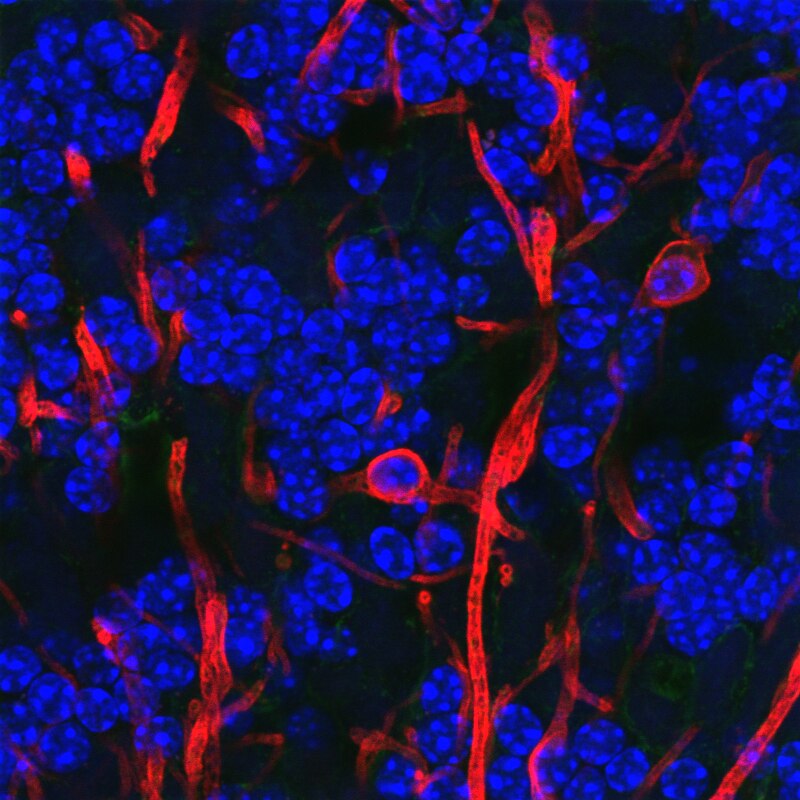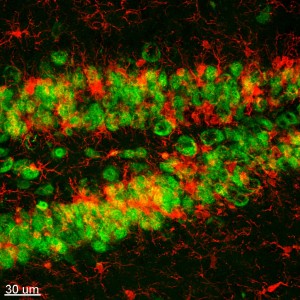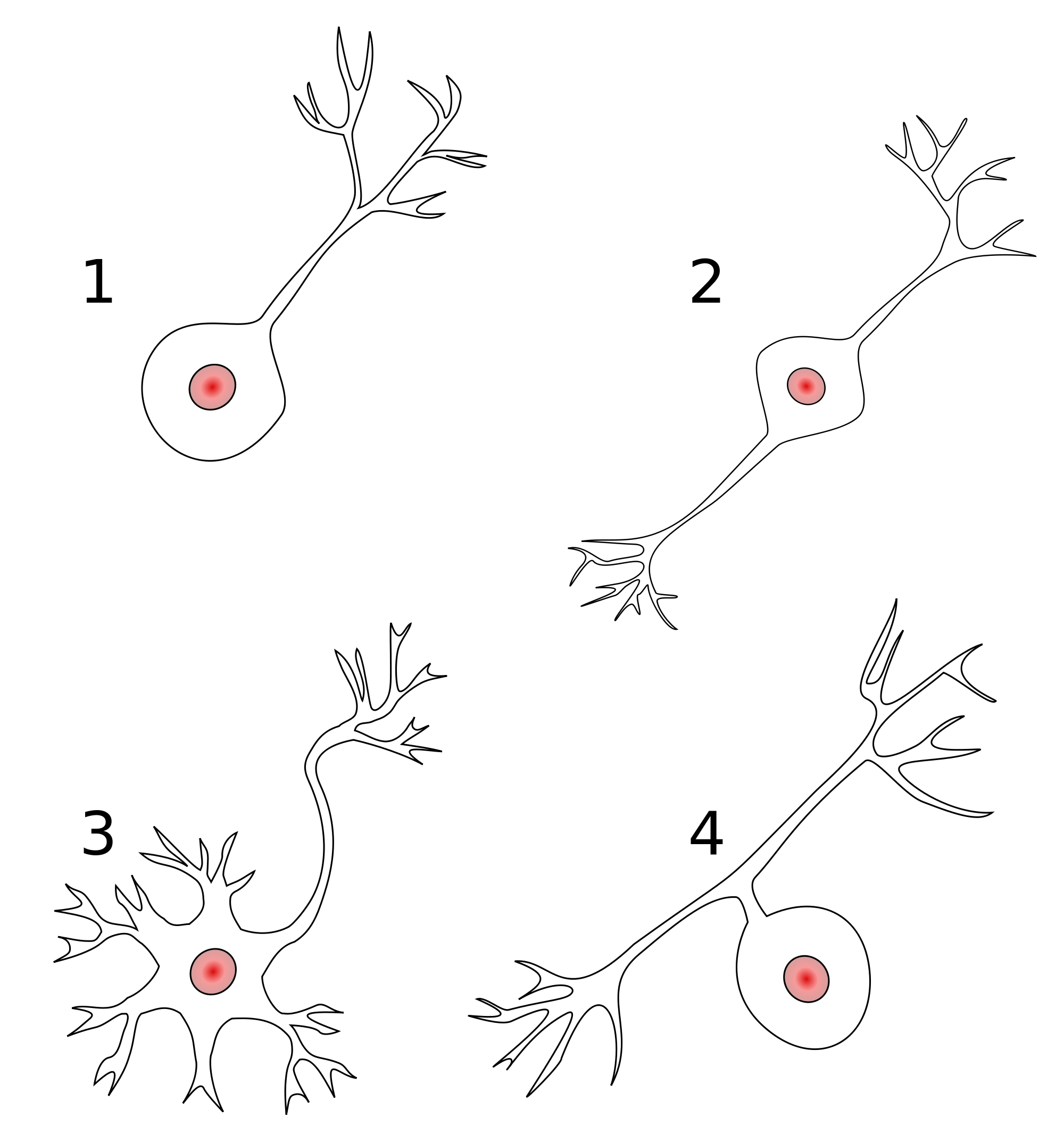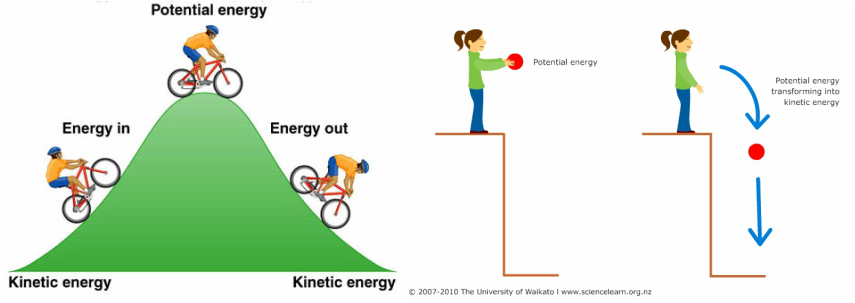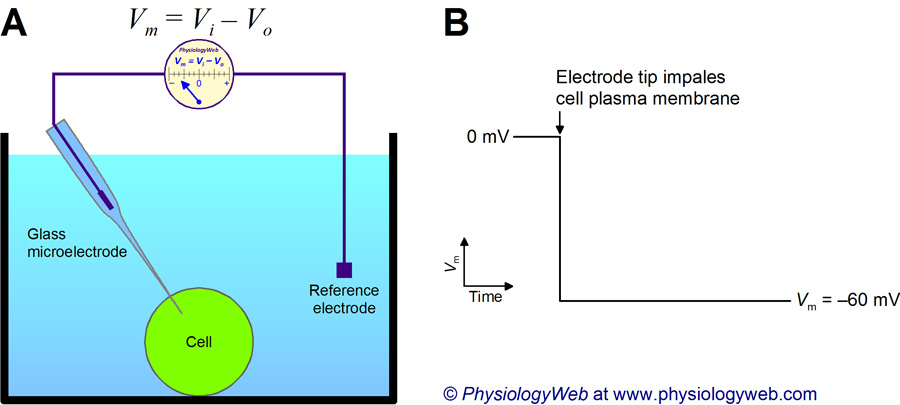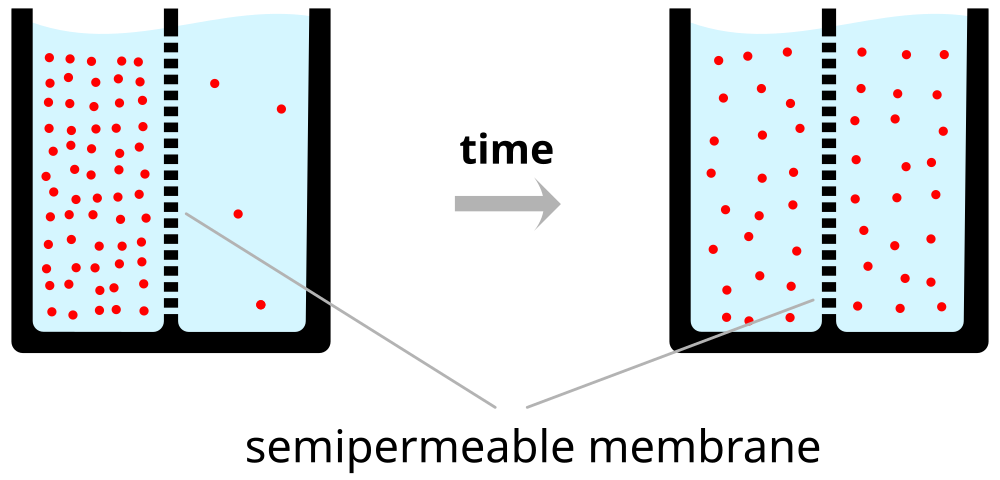- Mic on
- Zoom share screen, set sound output
- 2nd computer connect to Zoom
- Projector on
2020-09-15 09:52:50
Pre-check
How to play EyeWire (03:56)
Announcements
- Quiz 1 key (with explanations)
- Exam 1 next Thursday, 9/24
- 40 questions
- Complete 1 “component/section” in EyeWire, earn 5 extra credit points.
- Take screen shot, email to Shekoo
- Due before Friday, 10/16
Today’s Topics
- Cells of the nervous system
- Glia
- Neurons
- How do these cells communicate?
Cells of the nervous system
How many neurons and glia?
- Old “lore”: ~100 billion neurons
- New estimate (Azevedo et al., 2009)
- ~86 +/- 8 billion neurons
- ~85 +/- 9 billion glia
- 100-500 trillion synapses, 1 billion/mm^3
Could you count to 170 billion?
- How many years to count to 170 billion?
- 60 s/min x 60 min/hr x 24 hrs/day x 365 days/ yr = 31,536,000 s/yr
- 1.7e11/31,536,000 = 5,390 years
Mass, Neurons, Non-Neurons
Neurons by brain mass
Non-neuronal cells by brain mass
How many neurons and glia?
“These findings challenge the common view that humans stand out from other primates in their brain composition and indicate that, with regard to numbers of neuronal and nonneuronal cells, the human brain is an isometrically scaled-up primate brain.”
The Human Advantage

Glia (neuroglia)
- “Glia” means glue
- Functions
- Structural support
- Metabolic support
- Brain development
- Neural plasticity?
Astrocytes
- “Star-shaped”
- Physical and metabolic support
- Blood/brain barrier
- Regulate concentration of key ions (Ca++/K+) for neural communication
- Regulate concentration of key neurotransmitters (e.g., glutamate)
Astrocytes
- Shape brain development, synaptic plasticity
- Regulate local blood flow
- Regulate/influence communication between neurons, (Bazargani & Attwell, 2016)
- Disruption linked to cognitive impairment, disease (Chung, Welsh, Barres, & Stevens, 2015)
Astrocytes
Myelinating cells
- Produce myelin or myelin sheath
- White, fatty substance
- Surrounds many neurons
- The “white” in white matter
- Provide electrical/chemical insulation
- Make neuronal messages faster, less susceptible to noise
Types of myelin-producing cells
- Oligodendrocytes
- In brain and spinal cord (CNS)
- 1:many neurons
- Schwann cells
- In PNS
- 1:1 neuron
- Facilitate neuro-regeneration
Oligodendrocytes
Schwann Cells
Microglia
- Phagocytosis
- Clean-up damaged, dead tissue
- Prune synapses in normal development and disease
- Disruptions in microglia pruning -> impaired functional brain connectivity and social behavior, (Zhan et al., 2014)
Microglia
Neurons
Fun facts about neurons
- Specialized for electrical & chemical communication
- Post-mitotic – don’t divide
- Most born early in life, (Bhardwaj et al., 2006)
- Among longest-lived cells in body, may scale with organism lifespan (Magrassi, Leto, & Rossi, 2013)
- Can extend over long distances
Macrostructure of neurons
Structure of neurons
Dendrites
- Branch-like “extrusions” from cell body
- Majority of input to neuron
- Cluster close to cell body/soma
- Usually receive info
- Passive (do not regenerate electrical signal) vs. active (regenerate signal)
- Spines
Dendrites
Dendritic Spines
Soma (cell body)
- Varied shapes
- Nucleus
- Chromosomes
- Organelles
- Mitochonrdria
- Smooth and Rough Endoplasmic reticulum (ER)
Soma
Axons
- Another branch-like “extrusion” from soma
- Extend farther than dendrites
- Usually transmit info
Axons
- Parts
- Initial segment (closest to soma, unmyelinated)
- Nodes of Ranvier (unmyelinated segments along axon)
- Terminals, axon terminals, terminal buttons, synaptic terminals, synaptic boutons
Axons
Synaptic bouton (terminal button)
- Synapse (~5-10K per neuron)
- Presynaptic membrane (sending cell) and postsynaptic (receiving cell) membrane
- Synaptic cleft – space between cells
- Synaptic vesicles
- Pouches of neurotransmitters
- Autoreceptors (detect NTs); transporters (transport NTs across membrane)
Synaptic bouton (terminal button)
Classifying neurons
- Functional role
- Input (sensory), output (motor/secretory), interneurons
- Anatomy
- Unipolar
- Bipolar
- Multipolar
Classifying neurons
- By specific anatomy
- Pyramidal cells
- Stellate cells
- Purkinje cells
- Granule cells
Neurons by type
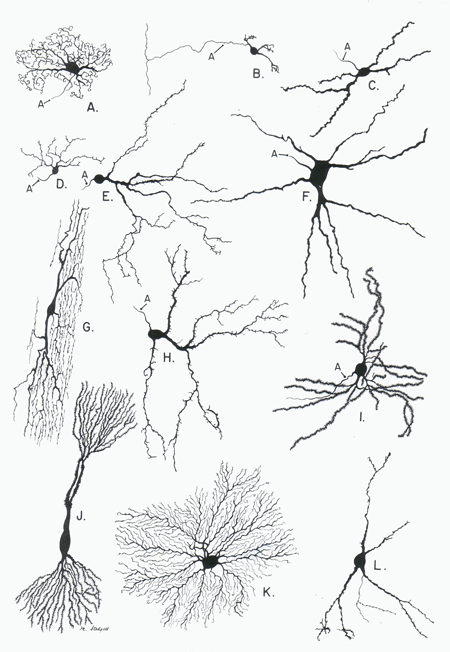
How neurons communicate
Neural communication
- Electrical
- Fast(er)
- Metabolically costly
- Within neurons
Neural communication
- Chemical
- Slow(er)
- Metabolically cheap
- Between neurons, & brain <-> body (via hormones)
How are messages generated?
- Electrical potential (== voltage)
- Think of potential energy
- Voltage ~ pressure
- Energy that will be released if something changes
Potential energy
Types of neural electrical potentials
Resting potential
- How to measure
- Electrode on inside
- Electrode on outside
- Inside - Outside = potential
Resting potential
Resting potential
- Neuron (and other cells) have potential energy
- Inside neuron is -60-70 mV, with respect to outside
- About 1/20th typical AAA battery
- Like charges repel, opposites attract, so
- Positively charged particles pulled in
- Negatively charged particles pushed out
Where does the resting potential come from?
- Ions
- Ion channels
- Separation between charges
- A balance of forces
We are the champIONs, my friend
- Potassium, K+
- Sodium, Na+
- Chloride, Cl-
- Organic anions, A-
Resting potential arises from
- A balance of forces
- Force of diffusion
- Electrostatic force
- Forces cause ion flows across membrane
- Ion channels allow ion flow
Ion channels
- Openings in neural membrane
- Selective
- Vary in permeability
Ion channel Types
- Passive/leak
- Always open
- Voltage-gated
- Open/close at certain voltages
Ion channel Types
- Ligand-gated (chemically-gated)
- Open/close in presence of special chemicals (ligands)
- Transporters/pumps
- Move (transport/pump) ions using metabolic energy
Ion channels
Neuron at rest permeable to K+
- Passive K+ channels open
- [K+] concentration inside >> outside
- Transporter pumps K+ in
- And then, K+ flows out
- Force of diffusion
Force of diffusion
Force of diffusion
Neuron at rest permeable to K+
- Organic anions (A-) too large to move outside of cell
- A- and K+ largely in balance == no net internal charge
- K+ outflow creates charge separation: K+ <-> A-
- Charge separation creates a voltage
- Outside +/inside -
- Voltage build-up stops outflow of K+ (before inside/outside concentrations are ==)
The resting potential
Balance of forces in the neuron at rest
- Force of diffusion
- K+ moves from high concentration (inside) to low (outside)
Balance of forces in the neuron at rest
- Electrostatic force
- Positive K+ accumulate along outside
- Negative A- accumulate along inside
- K+ || A- along membrane creates battery-like voltage
- Voltage build-up stops K+ outflow
Electrostatic force
- Specific voltage called equilibrium potential for K+
- K+ positive, so equilibrium potential negative (w/ respect to outside)
- Equilibrium potential close to neuron resting potential
Equilibrium potentials calculated under typical conditions
| Ion | [inside] | [outside] | Voltage |
|---|---|---|---|
| K+ | ~150 mM | ~4 mM | ~ -90 mV |
Electrical circuit model
Resting potential ≠ K+ equilibrium potential
- Resting potential not just due to K+ flow
- Other ions flow
- Resting potential == net effects of all ion flows across membrane
Next time
- More on neural communication
- What are the other ions doing?
References
Azevedo, F. A., Carvalho, L. R., Grinberg, L. T., Farfel, J. M., Ferretti, R. E., Leite, R. E., … others. (2009). Equal numbers of neuronal and nonneuronal cells make the human brain an isometrically scaled-up primate brain. Journal of Comparative Neurology, 513(5), 532–541.
Bazargani, N., & Attwell, D. (2016). Astrocyte calcium signaling: The third wave. Nature Neuroscience, 19(2), 182–189. https://doi.org/10.1038/nn.4201
Bhardwaj, R. D., Curtis, M. A., Spalding, K. L., Buchholz, B. A., Fink, D., Björk-Eriksson, T., … Frisén, J. (2006). Neocortical neurogenesis in humans is restricted to development. Proceedings of the National Academy of Sciences, 103(33), 12564–12568. https://doi.org/10.1073/pnas.0605177103
Chung, W.-S., Welsh, C. A., Barres, B. A., & Stevens, B. (2015). Do glia drive synaptic and cognitive impairment in disease? Nature Neuroscience, 18(11), 1539–1545. https://doi.org/10.1038/nn.4142
Magrassi, L., Leto, K., & Rossi, F. (2013). Lifespan of neurons is uncoupled from organismal lifespan. Proceedings of the National Academy of Sciences, 110(11), 4374–4379. https://doi.org/10.1073/pnas.1217505110
Zhan, Y., Paolicelli, R. C., Sforazzini, F., Weinhard, L., Bolasco, G., Pagani, F., … Gross, C. T. (2014). Deficient neuron-microglia signaling results in impaired functional brain connectivity and social behavior. Nature Neuroscience, 17(3), 400–406. https://doi.org/10.1038/nn.3641

